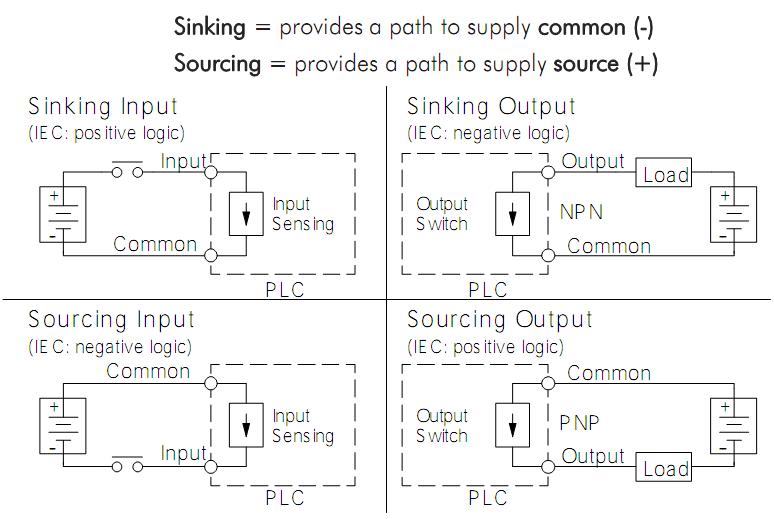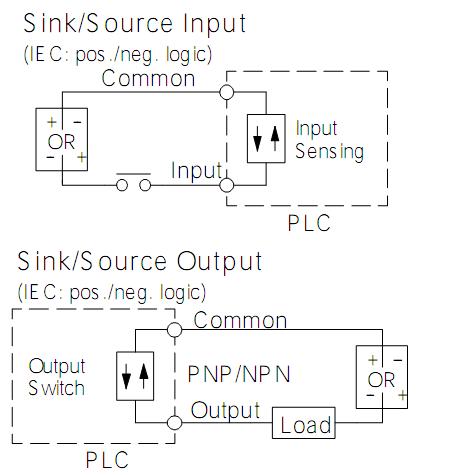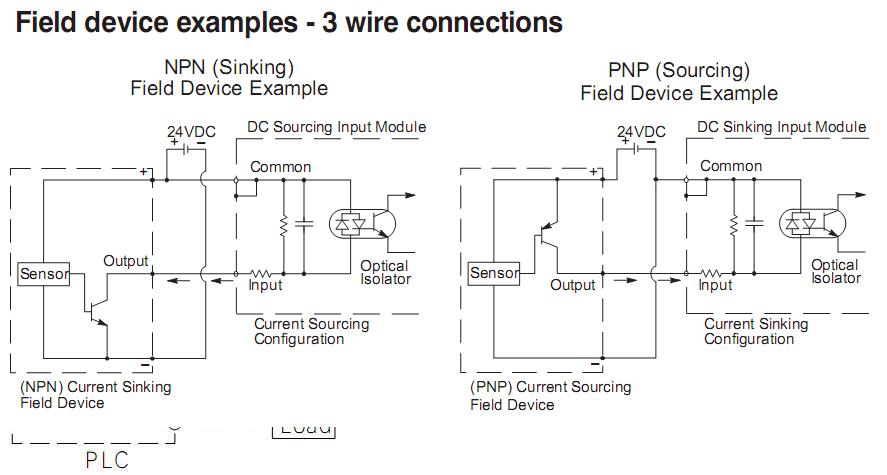Sinking and Sourcing Concepts
漏和源的概念
When choosing the type of input or output module for your system (or DL05/DL06/DL105 I/O type), it is very important to have a solid understanding of sinking and sourcing concepts. Use of these terms occurs frequently in discussion of input or output circuits. It is the goal of this section to make these concepts easy to understand, so you can make the right choice the first time when selecting the type of I/O points for your application. This section provides short definitions, followed by general example circuits.
当您为您的系统(或DL05/DL06/DL105的I/ O型)选择模块的输入或输出类型时,对漏型和源型的概念有一个非常扎实的理解是非常重要的。在讨论输入或输出电路时会经常使用这些术语。把这些概念很容易理解是本节的目标,当您第一次为您的程序选择I/O点的类型时,您可以做出正确的选择。这个部分提供简短的定义,随后是一般的电路实例。
First you will notice that the diagrams on this page are associated with only DC circuits and not AC, because of the reference to (+) and (-) polarities. Therefore, sinking and sourcing terminology applies only to DC input and output circuits. Input and output points that are sinking or sourcing can conduct current in one direction only. This means it is possible to connect the external supply and field device to the I/O point, with current trying to flow in the wrong direction, and the circuit will not operate. However, the supply and field device can be connected every time based on an understanding of sourcing and sinking.
首先,你会发现本页上的图都与只与直流电路有关系,而不是交流,因为涉及到(+)和(-)极性。因此,术语漏和源只适用于直流输入和输出电路。漏和源输入、输出可以以一个方向导通电流。这意味着它可能连接外部电源和现场设备到I / O点上,而电流试图流向错误的方向时, 电路将无法运行。但在理解了源和漏的基础上,电源和现场设备每次可以连接。
The figure below depicts a sinking input. To properly connect the external supply, it must be connected so the input provides a path to supply common (-). So, start at the PLC input terminal, follow through the input sensing circuit, exit at the common terminal, and connect the supply (-) to the common terminal. By adding the switch between the supply (+) and the input, the circuit is completed. Current flows in the direction of the arrow when the switch is closed.
下图描述了一个漏输入。 要正确地连接外部电源,它必须连接,使输入提供一个到电源公共端( - )的路径。因此,从PLC的输入端子开始,流经输入感测电路,在公共端子退出,然后连接到电源(-)的公共端子。在电源(+)和输入间加入开关, 电路完成。电流顺着箭头的方向流动时,开关闭合。

By applying the circuit principles to the four possible combinations of input/output sinking/sourcing types, there are four circuits, as shown above. The common terminal is the terminal that serves as the common return path for all I/O points in the bank.
通过应用电路的原则,得到四个可能的输入/输出,漏/源组合,如上图所示,有4个 电路。公共端是充当所有I/O点公共回路的终端。
Sink/source I/O circuits combine sinking and sourcing capabilities. This means that the I/O circuitry in the PLC will allow current to flow in either direction, as shown at the right. The common terminal connects to one polarity, and the I/O point connects to the other polarity (through the field device). This provides flexibility in making connections to your field power supply. Please note:
l Wire all I/O points with a shared common as either sinking or sourcing.
l Do not use an AC power supply on a DC sink/source I/O point.
漏/源I/O电路结合了漏型和源型的能力。这意味着在PLC的I/O电路允许电流在两个方向流动,如下图所示。在正确的。公共端连接到一个极,I/O点连接到其他极性(通过现场设备)。这提高了连接到您现场电源的灵活性。请注意:
l 将所有的I/O点连接到一个共用的地作为要么是漏有么是源。
l 不要在直流漏/源I/O点上使用交流电源。



























 960
960

 被折叠的 条评论
为什么被折叠?
被折叠的 条评论
为什么被折叠?








